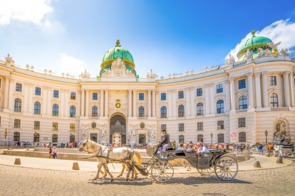
11-12 May
Setting sail from Vilshofen
Vilshofen an der Donau is known as the 'Little Town of Three Rivers', situated at the point where the Vils and Wolfach flow into the Danube. At its heart is the delightful old town, home to several interesting buildings including the Church of St John the Baptist, the Benedictine Abbey of Schweiklberg and the iconic clock tower.

12 May
Germany: Passau

The pretty Bavarian town of Passau, situated close to Germany’s border with Austria, enjoys a unique setting at the confluence of three rivers: the Inn, the Ilz and the Danube. The narrow cobbled streets of the handsome old town, the Altstadt, are quite delightful.
13 May
Austria: Grein
13 May
Austria: Linz (Salzburg)

The city of Linz is included on river cruise itineraries due to its proximity to Salzburg, which is where you’ll most likely be headed. Salzburg’s Altstadt attracts millions of visitors every year with its fairytale skyline of domes and spires, and the city is renowned as both the birthplace of Mozart and the setting for ‘The Sound of Music’.
14 May
Austria: Spitz
14 May
Austria: Melk

The riverside village of Melk is best known for its spectacular abbey, a Baroque masterpiece that dominates the landscape. A Benedictine abbey was first established here in 1089, and the 18th century reconstruction that you can see today is still a working monastery.
15 May
Austria: Vienna

Formerly the centre of the Habsburg Empire, Vienna is as grand a European capital as you can imagine, jam packed full of thrusting, bombastic buildings that stand as a reminder of Austria’s glorious imperial heyday.
16 May
Slovakia: Bratislava

Bratislava, Slovakia’s quaint little capital, straddles the Danube close to the border with Austria and Hungary. The compact old town is the best place to begin your exploration, before heading up to the hilltop castle for commanding views of the city and surrounding countryside.
17-18 May
Hungary: Budapest

Budapest is one of Eastern Europe’s most appealing cities, a vibrant and welcoming capital that straddles the Danube. The history of Budapest has been somewhat turbulent, but plenty of beautiful buildings survive, including the imposing Parliament and iconic St Stephen’s Basilica.
19 May
Hungary: Mohács

Mohács was the scene of a decisive battle in 1526 that brought Hungary under Ottoman control, but is best known these days for its Busó carnival in February, when men in creepy-looking costumes take to the streets to celebrate the end of winter. The town is also a jumping off point for the attractive city of Pécs, half an hour’s drive away.
20 May
Croatia: Vukovar

Vukovar is one of the great tragedies of the Balkan wars, a once prosperous and elegant city reduced to rubble by fierce fighting between Croats and Serbs. There are green shoots of optimism as the city rebuilds, but the battle-scarred streets are a powerful reminder of the devastating conflicts of the 1990s.
21 May
Serbia: Belgrade

Belgrade has been invaded and occupied dozens of times over the centuries, a fact that's reflected in the mish-mash of architectural styles, from Ottoman and Art Nouveau to grim relics of the communist era. But Belgrade is also a city with real soul, emerging from a difficult recent history as one of Europe’s most exciting capitals.
22 May
Romania: Iron Gates

As the Danube wends its way east, along the border between Serbia and Romania, the river narrows to a dramatic gorge known as the Iron Gates. The river here is flanked by a huge stone carving of Decebalus, the last king of the Dacians and a Romanian national hero.
23 May
Bulgaria: Vidin

The riverside town of Vidin is situated in the north west corner of Bulgaria, close to the border with Romania and Serbia. The architectural highlight is the magnificently well preserved Baba Vida fortress, and the town is also home to a mosque, a synagogue and several churches.
24 May
Bulgaria: Ruse

The Bulgarian city of Ruse (also written ‘Rousse’) sits on the right bank of the Danube just opposite the Romanian city of Giurgiu, and is one of the country’s most attractive cities. Sometimes known as ‘Little Vienna’, thanks to the plethora of Neo-Baroque and Neo-Rococo architecture, it’s a highlight of any cruise along this stretch of the Danube.
25 May
Arriving in Giurgiu
The river port of Giurgiu is situated just across the Danube from the Bulgarian city of Ruse, and the two cities are linked by a cross-border Friendship Bridge. You're unlikely to spend much time in Giurgiu itself, but the port is the start and end point for river cruises on the lower Danube, and is linked by road and rail to Romania's capital, Bucharest.

Your home from home



What we love
The extra space on board AmaMagna means large, luxurious, ocean-type staterooms averaging over 300 square feet, lots of dining options, and expansive spa and fitness areas. There will also be something totally new - a retractable watersports platform.
| Capacity | 196 Guests |
|---|---|
| Crew | 70 European Staff |
| Style |
Relaxed and informal during the day, giving way to an elegant evening atmosphere. |
| Inclusions |
|










